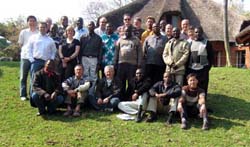Co-Chairs Report #1 October 3, 2008
Japhet Ndhlovu, Neil Crosbie, Alan Roxburgh
Dear Friends:
Warm greetings to each of you in the diverse contexts of ministry around the world where we live and minister in the name of Christ.
It is hard to believe our meetings took place more than a month ago. After the Lusaka meetings each of us returned to busy lives. We determined that Neil, Japhet and Alan would co-chair the next stages of our work and shape the agenda around the steps forward we had agreed on together. Both Neil and Japhet had to travel extensively outside their own countries in August so it was only at the beginning of last week that the three of us were able to arrange a Skype call with one another. We appreciate your patience.
One of our first tasks was to personally review the Lusaka meetings. Our common experience was that Lusaka had gone very well. We achieved the community and communication we were seeking across a diverse, multi-national and multi-cultural set of relationships. The three of us felt we were able to integrate “Western” and African voices thanks to the wonderful preparation and guidance of key people like Frederick and Jurgens. We believe that Lusaka was a special event of potential Kingdom significance. We recognize the responsibility and gift we have been given to guide this process forward and recognize the level of challenge this project will require of us all in terms of communication and the actual implementation of the decisions we made. Thank you, each one, for contributing to making Lusaka something we might have dreamed of happening but probably didn’t imagine possible. The Lord was with us.

 I always seem to require a week at least to both intellectually and emotionally process my trips to Africa and this time I asked myself why? I have come to the conclusion that travelling to sub Saharan Africa and really experiencing the enormous economic and social transitions that are presently going on as well as enjoying the natural hospitality of the African people is probably a picture of what it was like to move into London or Manchester during the industrial revolution of the 19th century. All around you watch and experience the disorientating effects of modernization while still enjoying, for the time being at least, traditional African values and ways of life.
I always seem to require a week at least to both intellectually and emotionally process my trips to Africa and this time I asked myself why? I have come to the conclusion that travelling to sub Saharan Africa and really experiencing the enormous economic and social transitions that are presently going on as well as enjoying the natural hospitality of the African people is probably a picture of what it was like to move into London or Manchester during the industrial revolution of the 19th century. All around you watch and experience the disorientating effects of modernization while still enjoying, for the time being at least, traditional African values and ways of life. Until quite recently these very same people were struggling on the
Until quite recently these very same people were struggling on the The Christendom phase of the Christian movement is drawing to a decisive close.
The Christendom phase of the Christian movement is drawing to a decisive close. The main thing is to keep the main thing the main thing. This task, while belonging to all congregational leadership, and all members of the staff, must be the highest priority for the pastor of the congregation, the one who has the call to such leadership.
The main thing is to keep the main thing the main thing. This task, while belonging to all congregational leadership, and all members of the staff, must be the highest priority for the pastor of the congregation, the one who has the call to such leadership. There is no easy formula: do these three things and you will be a missional church. There is no handy checklist of activities you can perform in order to be successful. Instead, researchers have identified eight somewhat overlapping “Patterns” that they have found in missional congregations. These are explained in more detail in the book Treasure in Clay Jars, where you will also find congregational stories illustrating these Patterns.
There is no easy formula: do these three things and you will be a missional church. There is no handy checklist of activities you can perform in order to be successful. Instead, researchers have identified eight somewhat overlapping “Patterns” that they have found in missional congregations. These are explained in more detail in the book Treasure in Clay Jars, where you will also find congregational stories illustrating these Patterns.